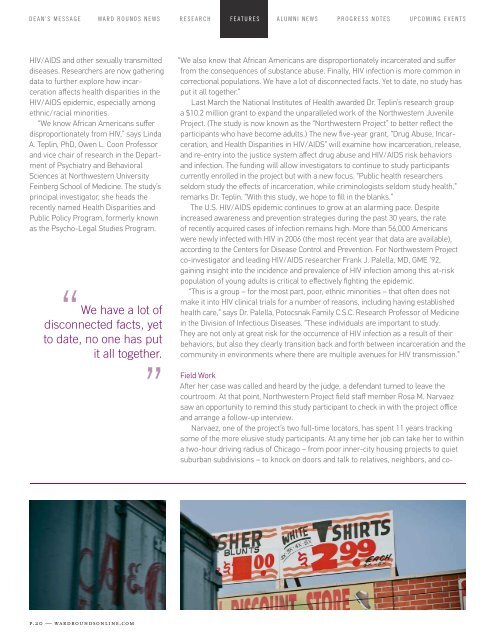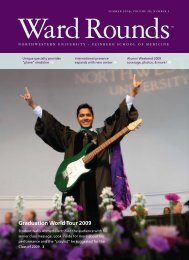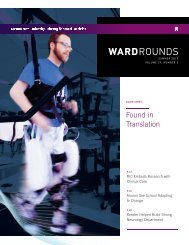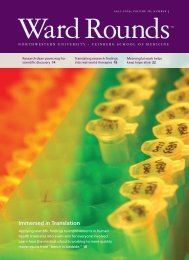Download PDF - Ward Rounds - Northwestern University
Download PDF - Ward Rounds - Northwestern University
Download PDF - Ward Rounds - Northwestern University
You also want an ePaper? Increase the reach of your titles
YUMPU automatically turns print PDFs into web optimized ePapers that Google loves.
DEAN’S MESSAGE WARD ROUNDS NEWS RESEARCH FEATURES ALUMNI NEWS PROGRESS NOTES UPCOMING EVENTS<br />
HIV/AIDS and other sexually transmitted<br />
diseases. Researchers are now gath ering<br />
data to further explore how incarceration<br />
aff ects health disparities in the<br />
HIV/AIDS epidemic, especially among<br />
ethnic/racial minorities.<br />
“We know African Americans suff er<br />
disproportionately from HIV,” says Linda<br />
A. Teplin, PhD, Owen L. Coon Professor<br />
and vice chair of research in the Department<br />
of Psychiatry and Behavioral<br />
Sciences at <strong>Northwestern</strong> <strong>University</strong><br />
Feinberg School of Medicine. The study’s<br />
principal investigator, she heads the<br />
recently named Health Disparities and<br />
Public Policy Program, formerly known<br />
as the Psycho-Legal Studies Program.<br />
“<br />
We have a lot of<br />
disconnected facts, yet<br />
to date, no one has put<br />
it all together.<br />
“<br />
“We also know that African Americans are disproportionately incarcerated and suff er<br />
from the consequences of substance abuse. Finally, HIV infection is more common in<br />
correctional populations. We have a lot of disconnected facts. Yet to date, no study has<br />
put it all together.”<br />
Last March the National Institutes of Health awarded Dr. Teplin’s research group<br />
a $10.2 million grant to expand the unparalleled work of the <strong>Northwestern</strong> Juvenile<br />
Project. (The study is now known as the “<strong>Northwestern</strong> Project” to better refl ect the<br />
participants who have become adults.) The new fi ve-year grant, “Drug Abuse, Incarceration,<br />
and Health Disparities in HIV/AIDS” will examine how incarceration, release,<br />
and re-entry into the justice system aff ect drug abuse and HIV/AIDS risk behaviors<br />
and infection. The funding will allow investigators to continue to study participants<br />
currently enrolled in the project but with a new focus. “Public health researchers<br />
seldom study the eff ects of incarceration, while criminologists seldom study health,”<br />
remarks Dr. Teplin. “With this study, we hope to fi ll in the blanks.”<br />
The U.S. HIV/AIDS epidemic continues to grow at an alarming pace. Despite<br />
increased awareness and prevention strategies during the past 30 years, the rate<br />
of recently acquired cases of infection remains high. More than 56,000 Americans<br />
were newly infected with HIV in 2006 (the most recent year that data are available),<br />
according to the Centers for Disease Control and Prevention. For <strong>Northwestern</strong> Project<br />
co-investigator and leading HIV/AIDS researcher Frank J. Palella, MD, GME ’92,<br />
gaining insight into the incidence and prevalence of HIV infection among this at-risk<br />
population of young adults is critical to eff ectively fi ghting the epidemic.<br />
“This is a group – for the most part, poor, ethnic minorities – that oſt en does not<br />
make it into HIV clinical trials for a number of reasons, including having established<br />
health care,” says Dr. Palella, Potocsnak Family C.S.C. Research Professor of Medicine<br />
in the Division of Infectious Diseases. “These individuals are important to study.<br />
They are not only at great risk for the occurrence of HIV infection as a result of their<br />
behaviors, but also they clearly transition back and forth between incarceration and the<br />
community in environments where there are multiple avenues for HIV transmission.”<br />
1<br />
2 3<br />
workers in search of good contact information. As the third line of defense, Narvaez<br />
usually gets involved when eff orts to track participants have stymied the study’s offi cebased<br />
project liaisons. Three liaisons schedule interviews and send out “reminder”<br />
letters – and birthday cards – to participants, and 12 fi eld-based interviewers conduct<br />
three- to four-hour follow-up interviews. These and other staff members contribute<br />
to the well-orchestrated fi eld operation designed and led by co-investigator, Karen M.<br />
Abram, PhD, associate professor of psychiatry and behavioral sciences and associate<br />
director of the Health Disparities and Public Policy Program.<br />
“The most important feature of a successful longitudinal study is maintaining your<br />
sample,” explains Dr. Abram. “If you don’t retain your sample over time, your fi ndings<br />
could be meaningless. The characteristics you are studying may be the very ones<br />
exhibited by the people who are the hardest to track and fi nd. So ‘participation rate’ is<br />
defi nitely a household phrase around here.”<br />
Field visits are the key to success. Unlike many epidemiologic studies, field<br />
staff – most with master’s-level clinical training – interview the participants<br />
where they are living, whether they reside in the community or in correctional<br />
facilities. This point diff erentiates the <strong>Northwestern</strong> Project from other studies that<br />
oſt en lose participants when they become incarcerated. Project interviewers meet<br />
with participants in the most disparate places, from downstate prisons and strip clubs<br />
to fast-food restaurants and bookstores. One interview took place in the back of a<br />
U-Haul truck that was serving as a participant’s temporary home.<br />
Field Work<br />
Aſt er her case was called and heard by the judge, a defendant turned to leave the<br />
courtroom. At that point, <strong>Northwestern</strong> Project fi eld staff member Rosa M. Narvaez<br />
saw an opportunity to remind this study participant to check in with the project offi ce<br />
and arrange a follow-up interview.<br />
Narvaez, one of the project’s two full-time locators, has spent 11 years tracking<br />
some of the more elusive study participants. At any time her job can take her to within<br />
a two-hour driving radius of Chicago – from poor inner-city housing projects to quiet<br />
suburban subdivisions – to knock on doors and talk to relatives, neighbors, and cooriginal<br />
group<br />
of youth subjects<br />
was 1829. 15 years<br />
later, there<br />
are still 1655<br />
participants.<br />
1 field interviewer xavier mcelrathbey<br />
interviews subjects at home,<br />
work, or in jail.<br />
2 linda teplin, phd, is principal<br />
investigator for the northwestern<br />
project.<br />
3 northwestern project interviewers<br />
and trackers meet monthly to<br />
discuss issues and progress.<br />
“<br />
The most important<br />
feature of a successful<br />
longitudinal study is<br />
maintaining your sample.<br />
“<br />
p.20 — wardroundsonline.com<br />
ward rounds winter 2010-11 — p.21












